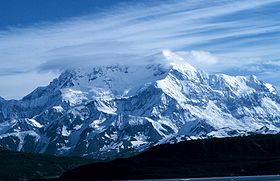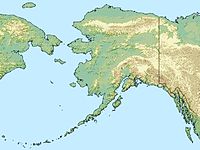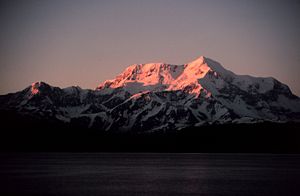- Mount Saint Elias
-
Mount Saint Elias 
Mount St. Elias from Icy Bay, AlaskaElevation 18,008 ft (5,489 m) [1] Prominence 11,250 ft (3,429 m) [2] Listing List of Ultras in Canada List of Ultras in the United States Location Location on Alaska/Yukon border Location Yakutat City and Borough, Alaska, USA / Yukon Territory, Canada Range Saint Elias Mountains Coordinates 60°17′36″N 140°55′46″W / 60.29333°N 140.92944°WCoordinates: 60°17′36″N 140°55′46″W / 60.29333°N 140.92944°W Topo map USGS Mt. Saint Elias Climbing First ascent 1897 by Duke of the Abruzzi Easiest route glacier/snow/ice climb - Mount Saint Elias may also refer to Mount Carmel
Mount Saint Elias, also designated Boundary Peak 186, is the second highest mountain in both Canada and the United States, being situated on the Yukon and Alaska border. It lies about 40 kilometres (25 mi) southwest of Mount Logan, the highest mountain in Canada. The Canadian side is part of Kluane National Park, while the U.S. side of the mountain is located within Wrangell-St. Elias National Park and Preserve.
Its name in Tlingit is Yaas'éit'aa Shaa, meaning "mountain behind Icy Bay", and is occasionally called Shaa Tléin "Big Mountain" by the Yakutat Tlingit. It is one of the most important crests of the Kwaashk'khwáan clan since they used it as a guide during their journey down the Copper River.[2] Mount Fairweather at the apex of the British Columbia and Alaska borders at the head of the Alaska Panhandle is known as Tsalxhaan, it is said this mountain and Yaas'éit'aa Shaa (Mt. St. Elias) were originally next to each other but had an argument and separated. Their children, the mountains in between the two peaks, are called Tsalxhaan Yatx'i ("Children of Tsalxaan").
The mountain was first sighted by European explorers on July 16, 1741 by Vitus Bering of Russia. While some historians contend that the mountain was named by Bering, others believe that eighteenth century mapmakers named it after Cape Saint Elias, when it was left unnamed by Bering.[1]
Mount Saint Elias is notable for being the highest peak in the world that is so close to tidewater; its summit rises only 10 miles (16 km) from the head of Taan Fjord, off of Icy Bay. This gives the peak immense vertical relief, comparable to that of Mount McKinley (Denali) or peaks in the Himalayas.
In 2007, a documentary movie called "Mount. St. Elias" was made about a team of skiier/mountaineers determined to make "the planet's longest skiing descent" – ascending the mountain and then skiing nearly all 18,000 feet down to the Gulf of Alaska; the movie finished editing and underwent limited release in 2009. The climbers ended up summiting on the second attempt and skiing down to 13,000 feet.[3]
Contents
Climbing history
Mt. St. Elias was first climbed on July 31, 1897 by an expedition led by famed explorer Prince Luigi Amadeo di Savoia, (who also reconnoitered the current standard route on K2) and including noted mountain photographer Vittorio Sella.
The second ascent was not until 1946, when a group from the Harvard Mountaineering Club including noted mountain historian Dee Molenaar climbed the Southwest Ridge route. The summit party comprised Molenaar, his brother Cornelius, Andrew and Betty Kauffman, Maynard Miller, William Latady, and Benjamin Ferris. (This expedition was somewhat unusual for the era in including a female member.) William Putnam was a member of the expedition but did not make the summit. They used eleven camps, eight of which were on the approach from Icy Bay, and three of which were on the mountain. They were supported by multiple air drops of food.[4]
Mount Saint Elias is infrequently climbed today, despite its height, due to the typically terrible weather conditions engendered by its proximity to the ocean.
Routes
- Abruzzi Ridge
See also
- 4000 meter peaks of Alaska
- 4000 metre peaks of Canada
- 4000 meter peaks of North America
- 4000 meter peaks of the United States
- Mountain peaks of Alaska
- Mountain peaks of Canada
- Mountain peaks of North America
- Mountain peaks of the United States
- List of Boundary Peaks of the Alaska-British Columbia/Yukon border
References
- ^ a b "Mount Saint Elias". Geographic Names Information System, U.S. Geological Survey. http://geonames.usgs.gov/pls/gnispublic/f?p=gnispq:3:::NO::P3_FID:1416521. Retrieved 2007-10-31.
- ^ a b "Mount Saint Elias". Bivouac.com. http://www.bivouac.com/MtnPg.asp?MtnId=274. Retrieved 2004-10-01.
- ^ Mount St. Elias – Official Movie Site. Retrieved March 11, 2010.
- ^ Maynard Malcolm Miller, "Yahtsétesha", American Alpine Journal, 1947, pp. 257-268.
Works cited
- Michael Wood and Colby Coombs, Alaska: a climbing guide, The Mountaineers, 2001.
External links
Categories:- Mountains of Alaska
- Mountains of Yukon
- Saint Elias Mountains
- United States National Park high points
- Landforms of Yakutat City and Borough, Alaska
- Wrangell–St. Elias National Park and Preserve
- Kluane National Park and Reserve
- Canada–United States border
- International mountains of North America
Wikimedia Foundation. 2010.


